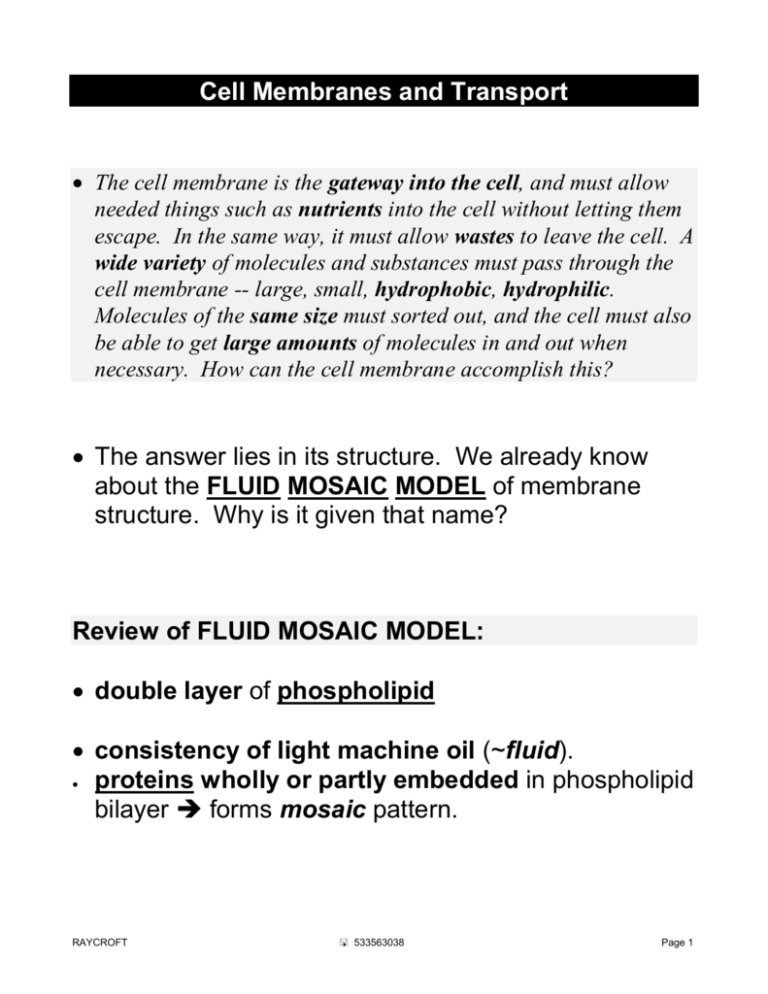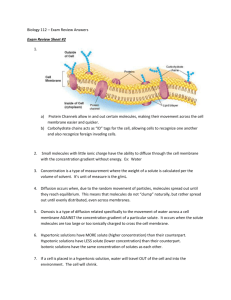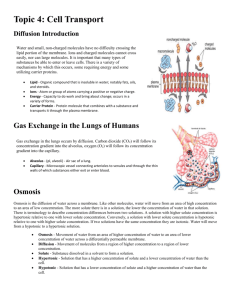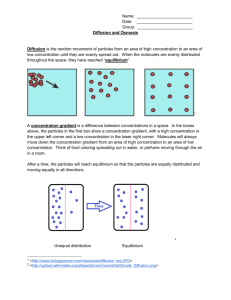BIOLOGY 12 - Cell Membrane and Cell Wall Function
advertisement

Cell Membranes and Transport The cell membrane is the gateway into the cell, and must allow needed things such as nutrients into the cell without letting them escape. In the same way, it must allow wastes to leave the cell. A wide variety of molecules and substances must pass through the cell membrane -- large, small, hydrophobic, hydrophilic. Molecules of the same size must sorted out, and the cell must also be able to get large amounts of molecules in and out when necessary. How can the cell membrane accomplish this? The answer lies in its structure. We already know about the FLUID MOSAIC MODEL of membrane structure. Why is it given that name? Review of FLUID MOSAIC MODEL: double layer of phospholipid consistency of light machine oil (~fluid). proteins wholly or partly embedded in phospholipid bilayer forms mosaic pattern. RAYCROFT 533563038 Page 1 carbohydrates strung together in chains are attached to proteins ("glycoproteins") or lipids ("glycolipids") of membrane. Function as identification markers for cell recognition (helps immune system identify which cells belong to body and which are invaders). The cell membrane can discriminate between different molecules (even those of the same size) so we say it is SELECTIVELY PERMEABLE. THERE ARE THREE GENERAL MEANS BY WHICH SUBSTANCE CAN ENTER AND EXIT CELLS: Name Examples 1. DIFFUSION 2. TRANSPORT BY CARRIERS (active and facilitated transport) 3. ENDOCYTOSIS AND EXOCYTOSIS (e.g. pinocytosis and phagocytosis) RAYCROFT lipid-soluble molecules, water, gases sugars and amino acids sugars, amino acids., ions macromolecules (e.g. proteins), cells 533563038 Page 2 DIFFUSION BEFORE AFTER diffusion is a physical process that can be observed with any type of particle. Law of Diffusion: particles MOVE FROM THE AREA OF GREATER CONCENTRATION TO THE AREA OF LESSER CONCENTRATION UNTIL EQUALLY DISTRIBUTED. for instance: opening a perfume bottle in corner of a room. The smell of perfume soon permeates the room because the molecules that make up the perfume have drifted to all parts of the room. e.g. dropping dye into water. movement by diffusion requires no energy to be added (although adding energy (i.e. heat) will speed it up). diffusion is a slow process. The rate of diffusion is affected by the … RAYCROFT 533563038 Page 3 1. concentration gradient (the difference in concentration of the diffusing molecules between the two regions) 2. size & shape of the molecules 3. temperature (kinetic molecular theory) Three Ways of increasing the rate of diffusion: 1. increase the temperature 2. increase the concentration gradient 3. decrease the size of the diffusing molecules The properties of the cell membrane allow few types of molecules to pass by diffusion: a. Lipid-soluble molecules like steroids and alcohols can diffuse directly across because the membrane itself is made of lipids. b.Water diffuses readily across membrane, probably through charged, protein-lined pores in the membrane (remember, water is not lipid-soluble) that will not allow anything else but water through. c.Gases (O2 and CO2) (important in cell respiration) RAYCROFT 533563038 Page 4 Osmosis the movement of water across a selectively permeable membrane is a special case of diffusion called OSMOSIS. Osmosis: the net movement of water molecules from the area of greater concentration to the area of lesser concentration across a selectively-permeable membrane. Solute: particles which are dissolved in water Solvent: liquid which dissolves the solute. This is water when we are talking about osmosis. Solution: combination of solute and solvent. Osmotic Pressure: the pressure due to the flow of water from the area of greater concentration to the area of lesser concentration. The greater the concentration difference across the membrane, the greater the osmotic pressure. In cellular systems, water can move easily across membranes, but other molecules can't. Therefore, it is often only water that can move and follow the law of diffusion. RAYCROFT 533563038 Page 5 According to the law of diffusion, water will move from where it is more concentrated (i.e. solution that has less solute in it) to where it is less concentrated (i.e. solution that has more solute in it). This has important consequences on living systems. Cells may be placed in solutions that contain the same number of solute molecules per volume as the cell (= isotonic solution), a greater number of solute molecules per volume (= hypertonic solution), or a lesser number of solute molecules per volume than the cell (= hypotonic solution). RAYCROFT 533563038 Page 6 Summary of what happens to ANIMAL CELLS placed in different tonicities of solution: Tonicity of Solution Cell is Put Into Net Movement of Water Effect on Cell Isotonic No net movement Remains the same Hypotonic Cell gains water Cell Swells & May Burst H2O Hypertonic Cell loses water “lysis” Cell Shrinks H2O “crenation” ISOTONIC ("same" "strength") solution: no net movement of water across membrane. Same number of solute molecules per unit volume Cells placed in such a solution neither gain or lose water a 0.9 percent solution of NaCl is isotonic to red blood cells (RBC). RAYCROFT 533563038 Page 7 HYPERTONIC Solutions ("greater" "strength") greater concentration of solute than the cell (and therefore a lesser [ ] of water if a cell is placed in hypertonic solution, water will leave the cell and the cell will shrivel up. This is called CRENATION in animal cells. e.g. a 10% solution of NaCl is hypertonic to RBC -they'll shrink HYPOTONIC Solutions ("hypo" means "less than") these solutions have lower concentration of solute than the cell contents. if cell placed in hypotonic solution, water will enter cell, it will swell and possibly burst. e.g. a salt solution with a concentration greater than 0.9% is hypotonic to RBC. RAYCROFT 533563038 Page 8 TRANSPORT BY CARRIERS FACILITATED TRANSPORT utilizes PROTEIN CARRIERS in cell membrane to control passage of molecules in and out of cell. are highly specific - each carrier passes only one type molecule molecules only pass along concentration gradient. REQUIRES NO ENERGY - is like diffusion in this sense explains how lipid-insoluble molecules like GLUCOSE and AMINO ACIDS cross the cell membrane. FACILITATED TRANSPORT BEFORE OUTSIDE CELL RAYCROFT INSIDE CELL 533563038 OUTSIDE CELL INSIDE CELL Page 9 ACTIVE TRANSPORT also performed by protein carriers REQUIRES ENERGY (ATP) moves molecules against the concentration gradient (i.e. in the opposite direction of diffusion). ACTIVE TRANSPORT BEFORE OUTSIDE CELL INSIDE CELL OUTSIDE CELL molecules move from area of lower concentration to area of higher concentration. INSIDE CELL Active Transport is vitally important to organisms: e.g. Iodine & Thyroid Gland. [I+] is low in blood, high in Thyroid Gland. Active Transport moves I+ from blood to thyroid. e.g. Na+ actively transported out of urine by kidney tubule cells e.g. sodium/potassium pump in nerve/muscle cells (see text). Moves Na+ from inside to outside of cell, and K+ from outside to inside. e.g. Na+ Cl- and cystic fibrosis - a genetic disease, usually fatal, caused by blockage of Cl- transport. RAYCROFT 533563038 Page 10









